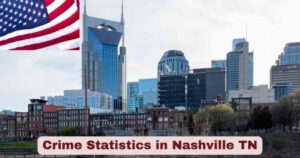Crime Cities in the US 2025
The landscape of crime cities in the US continues to evolve as American urban centers grapple with persistent public safety challenges. Despite significant improvements in overall crime statistics, certain metropolitan areas continue to experience elevated rates of violent and property crimes that impact millions of residents daily. Understanding the current state of highest crime cities in the US is crucial for policymakers, law enforcement agencies, and citizens who need accurate information to make informed decisions about their communities and safety.
Recent data from the Federal Bureau of Investigation (FBI) and the Council on Criminal Justice reveals a complex picture of American urban crime in 2025. While reported levels of 11 of the 13 offenses covered were lower in the first half of 2025 than in the first half of 2024, certain cities continue to struggle with significantly higher crime rates than the national average. The analysis of 42 American cities that consistently report monthly crime data provides the most comprehensive view of current crime trends, offering insights into which metropolitan areas face the greatest public safety challenges and what factors contribute to their elevated crime statistics.
Key Stats & Facts About Highest Crime Cities in the US 2025
| Crime Category | 2025 First Half Change | Notable Statistics | Key Cities Affected |
|---|---|---|---|
| Homicide Rate | -17% decrease | 327 fewer homicides | Baltimore, St. Louis, Memphis |
| Violent Crime | -10% decrease | Gun assaults down 21% | Detroit, Cleveland, Kansas City |
| Property Crime | -12% decrease | Motor vehicle theft -25% | Seattle, Portland, San Francisco |
| Aggravated Assault | -10% decrease | 5% below 2019 levels | Chicago, Philadelphia, Houston |
| Robbery Rate | -20% decrease | 30% below 2019 levels | Oakland, Atlanta, New Orleans |
| Burglary Rate | -19% residential | 47% below 2019 levels | Las Vegas, Phoenix, Tampa |
| Drug Offenses | No change | 27% below 2019 levels | Cincinnati, Columbus, Indianapolis |
| Domestic Violence | +3% increase | Only crime category rising | Milwaukee, Minneapolis, Buffalo |
The data reveals that while most crime categories have decreased significantly in 2025, certain cities continue to experience disproportionately high rates across multiple categories. The homicide rate during the first half of 2025 was 17% lower, on average, than during the same period in 2024, representing 327 fewer homicides across the analyzed cities. However, this improvement is not evenly distributed, with some metropolitan areas continuing to struggle with violence rates well above national averages.
Understanding these crime statistics 2025 requires examining both the immediate trends and longer-term patterns that have shaped American urban crime. The data shows that while violent crime has generally decreased, property crimes have shown mixed results, and certain cities continue to face significant challenges in specific categories. The persistence of high crime rates in particular metropolitan areas reflects complex socioeconomic factors, law enforcement strategies, and community dynamics that influence public safety outcomes across different urban environments.
Highest Crime Cities in the US
The comprehensive analysis of the highest crime cities in the US 2025 reveals concentrated patterns of public safety challenges across specific metropolitan areas that continue struggling with elevated violence and property crime rates despite national improvements. The FBI released detailed data on over 14 million criminal offenses for 2024, providing the foundation for understanding which cities face the greatest crime challenges. These highest crime cities represent diverse geographic regions and urban characteristics, yet share common challenges including economic inequality, population density issues, and complex law enforcement demands that require sustained intervention strategies.
Based on the latest FBI UCR statistics and Council on Criminal Justice data showing homicide and other violent crimes continue to fall below pre-pandemic levels in a sample of 42 U.S. cities, the ranking of America’s most dangerous cities reflects both persistent historical challenges and emerging crime trends. Memphis, St. Louis, Baltimore, Washington, DC, and Birmingham have the highest murder rates of all major US cities, while Baltimore is now the deadliest large city and Seattle leads in burglary rates. The top 25 crime cities in the US demonstrate how certain metropolitan areas continue experiencing disproportionate levels of violence and property crime.
| Rank | City | State | Murder Rate per 100K | Violent Crime Rate | Property Crime Rate | 2025 Status |
|---|---|---|---|---|---|---|
| 1 | St. Louis | Missouri | 87.83 | 2,082 per 100K | 6,749 per 100K | Murder Capital |
| 2 | Baltimore | Maryland | 58.27 | 2,027 per 100K | 4,417 per 100K | Deadliest Large City |
| 3 | Memphis | Tennessee | 49.15 | 2,421 per 100K | 6,297 per 100K | Top Murder Rate |
| 4 | Birmingham | Alabama | 50.62 | 1,746 per 100K | 4,888 per 100K | High Violence |
| 5 | Washington DC | District | 35.45 | 1,049 per 100K | 4,672 per 100K | Capital Crime |
| 6 | Detroit | Michigan | 41.45 | 2,056 per 100K | 3,985 per 100K | Persistent Challenge |
| 7 | Cleveland | Ohio | 33.70 | 1,557 per 100K | 4,383 per 100K | Rust Belt |
| 8 | Kansas City | Missouri | 31.82 | 1,590 per 100K | 5,011 per 100K | Regional Concern |
| 9 | Milwaukee | Wisconsin | 30.45 | 1,332 per 100K | 3,439 per 100K | Midwest Challenge |
| 10 | Chicago | Illinois | 25.10 | 967 per 100K | 2,983 per 100K | Volume Leader |
| 11 | Atlanta | Georgia | 24.63 | 1,379 per 100K | 4,850 per 100K | Southern Metro |
| 12 | New Orleans | Louisiana | 36.87 | 1,121 per 100K | 3,900 per 100K | Historic Problem |
| 13 | Oakland | California | 31.59 | 1,442 per 100K | 6,008 per 100K | Bay Area Leader |
| 14 | Philadelphia | Pennsylvania | 22.47 | 1,021 per 100K | 2,824 per 100K | Large City |
| 15 | Cincinnati | Ohio | 24.41 | 1,035 per 100K | 4,442 per 100K | Ohio Challenge |
| 16 | Houston | Texas | 19.87 | 1,252 per 100K | 3,945 per 100K | Texas Metro |
| 17 | Buffalo | New York | 26.15 | 1,085 per 100K | 3,533 per 100K | Upstate NY |
| 18 | Tampa | Florida | 14.32 | 562 per 100K | 2,816 per 100K | Florida Growth |
| 19 | Minneapolis | Minnesota | 18.43 | 1,101 per 100K | 4,231 per 100K | Twin Cities |
| 20 | Seattle | Washington | 6.98 | 736 per 100K | 5,258 per 100K | Property Leader |
| 21 | Las Vegas | Nevada | 12.40 | 818 per 100K | 2,838 per 100K | Tourism Impact |
| 22 | Phoenix | Arizona | 9.35 | 672 per 100K | 3,210 per 100K | Southwest Growth |
| 23 | Columbus | Ohio | 13.27 | 820 per 100K | 3,572 per 100K | State Capital |
| 24 | Indianapolis | Indiana | 24.19 | 1,254 per 100K | 3,984 per 100K | Midwest Metro |
| 25 | Portland | Oregon | 8.71 | 498 per 100K | 4,205 per 100K | Property Focus |
1. St. Louis, Missouri: St. Louis maintains the highest murder rate in America at 87.83 per 100,000 residents, earning its designation as the murder capital of the US 2025. The city’s violent crime rate of 2,082 per 100K reflects deep-rooted socioeconomic challenges including poverty, unemployment, and neighborhood segregation. Despite recent investments in violence intervention programs and community policing initiatives, St. Louis continues struggling with gun violence concentrated in specific districts. The metropolitan area has implemented comprehensive strategies combining law enforcement with economic development, yet progress remains uneven across different neighborhoods requiring sustained intervention efforts.
2. Baltimore, Maryland: Baltimore is now the deadliest large city with a murder rate of 58.27 per 100,000 and violent crime rate of 2,027 per 100K. The city faces complex challenges stemming from decades of industrial decline, population loss, and concentrated poverty in certain neighborhoods. Baltimore’s crime patterns reflect the intersection of drug trafficking, economic inequality, and limited opportunities for youth engagement. Recent initiatives including violence interruption programs, police reform efforts, and community investment have shown modest improvements, but the city requires comprehensive long-term strategies addressing both immediate public safety concerns and underlying community development needs.
3. Memphis, Tennessee: Memphis ranks among the top murder rate cities 2025 with 49.15 homicides per 100,000 residents and a violent crime rate of 2,421 per 100K. The city’s crime challenges reflect broader Southern urban patterns including economic transition, population changes, and persistent neighborhood inequality. Memphis has experienced particular difficulties with gun violence, aggravated assaults, and property crimes that affect both residential and business districts. The metropolitan area continues implementing community-based violence prevention programs, enhanced police-community partnerships, and economic development initiatives targeting high-crime areas, though sustained progress requires addressing complex socioeconomic factors contributing to elevated violence levels.
4. Birmingham, Alabama: Birmingham maintains a murder rate of 50.62 per 100,000 with violent crime at 1,746 per 100K, reflecting ongoing challenges facing post-industrial Southern cities. The metropolitan area struggles with concentrated poverty, limited economic opportunities, and neighborhoods experiencing disproportionate levels of violence. Birmingham’s crime patterns include significant concerns about gun violence, drug-related offenses, and property crimes that impact community stability. The city has invested in violence prevention initiatives, community policing programs, and neighborhood revitalization efforts, yet progress remains slow and requires comprehensive approaches that address both immediate public safety concerns and longer-term community development needs.
5. Washington DC, District: The nation’s capital experiences a murder rate of 35.45 per 100,000 and violent crime rate of 1,049 per 100K, presenting unique challenges for federal law enforcement coordination. Washington DC’s crime patterns reflect stark neighborhood disparities, with certain areas experiencing concentrated violence while others remain relatively safe. The metropolitan area faces particular concerns about carjackings, robberies, and gun violence that affect both residents and the millions of visitors to the capital region. Recent initiatives include enhanced federal-local law enforcement cooperation, community violence intervention programs, and investments in youth services, though addressing crime requires sustained coordination across multiple jurisdictions and government levels.
6. Detroit, Michigan: Detroit reports a murder rate of 41.45 per 100,000 with violent crime at 2,056 per 100K, reflecting ongoing recovery challenges following decades of economic decline. The city’s crime patterns correlate with neighborhood abandonment, concentrated poverty, and limited economic opportunities in certain districts. Detroit has experienced notable improvements in some crime categories through enhanced community policing, neighborhood investment, and economic development initiatives. However, certain areas continue struggling with elevated violence, property crimes, and drug-related offenses that require comprehensive intervention strategies. The metropolitan area’s recovery efforts demonstrate how cities can simultaneously address crime reduction and economic development through coordinated community partnerships.
7. Cleveland, Ohio: Cleveland experiences a murder rate of 33.70 per 100,000 and violent crime rate of 1,557 per 100K, exemplifying challenges facing Rust Belt cities managing post-industrial transitions. The metropolitan area struggles with concentrated poverty, population loss, and neighborhoods experiencing persistent violence despite various intervention efforts. Cleveland’s crime patterns include significant concerns about gun violence, aggravated assaults, and property crimes affecting both residential and commercial districts. The city has implemented comprehensive violence prevention strategies, community policing initiatives, and neighborhood revitalization programs, yet sustained progress requires addressing complex socioeconomic factors including unemployment, education, and housing that contribute to elevated crime levels.
8. Kansas City, Missouri: Kansas City reports a murder rate of 31.82 per 100,000 with violent crime at 1,590 per 100K, representing significant challenges for this major Midwest metropolitan area. The city experiences concentrated violence in specific neighborhoods while maintaining relatively stable conditions in other districts. Kansas City’s crime patterns include particular concerns about gun violence, robberies, and drug-related offenses that impact community safety and economic development. The metropolitan area has invested in violence intervention programs, enhanced police-community relations, and comprehensive community development initiatives. Progress has been measured but uneven, requiring sustained efforts that address both immediate public safety concerns and underlying factors contributing to neighborhood violence.
9. Milwaukee, Wisconsin: Milwaukee maintains a murder rate of 30.45 per 100,000 and violent crime rate of 1,332 per 100K, reflecting persistent challenges in this major Great Lakes metropolitan area. The city struggles with concentrated poverty, racial segregation, and neighborhoods experiencing disproportionate levels of violence despite various intervention efforts. Milwaukee’s crime patterns include significant concerns about gun violence, domestic violence incidents, and property crimes that affect community stability. The metropolitan area has implemented comprehensive violence prevention strategies, community policing programs, and neighborhood investment initiatives, yet sustained progress requires addressing complex socioeconomic factors including education, employment, and housing that contribute to elevated crime levels.
10. Chicago, Illinois: Chicago reports a murder rate of 25.10 per 100,000 but leads in total volume with 967 violent crimes per 100K, reflecting the challenges of managing public safety in America’s third-largest city. The metropolitan area experiences significant disparities between neighborhoods, with certain areas experiencing concentrated violence while others remain relatively safe. Chicago’s crime patterns include particular concerns about gun violence, carjackings, and property crimes that impact both residents and the city’s economic vitality. The city has invested heavily in violence prevention programs, police reform initiatives, and community development efforts, showing measurable improvements in certain categories while continuing to address persistent challenges in high-risk neighborhoods.
11. Atlanta, Georgia: Atlanta experiences a murder rate of 24.63 per 100,000 with violent crime at 1,379 per 100K, representing challenges facing rapidly growing Southern metropolitan areas. The city’s crime patterns reflect the intersection of economic growth, population changes, and persistent inequality in certain neighborhoods. Atlanta faces particular concerns about property crimes, robberies, and gun violence that affect both residential and business districts throughout the metropolitan region. The city has implemented comprehensive public safety strategies including enhanced police resources, community partnerships, and economic development initiatives targeting high-crime areas, though sustained progress requires addressing complex urban growth challenges while maintaining effective crime prevention efforts.
12. New Orleans, Louisiana: New Orleans maintains a murder rate of 36.87 per 100,000 with violent crime at 1,121 per 100K, reflecting historical challenges facing this unique metropolitan area. The city’s crime patterns stem from complex factors including concentrated poverty, limited economic opportunities, and neighborhoods experiencing persistent violence despite recovery efforts following Hurricane Katrina. New Orleans faces particular concerns about gun violence, drug-related offenses, and property crimes that impact both residents and the crucial tourism industry. The metropolitan area has invested in violence prevention programs, police reform initiatives, and comprehensive community development efforts, yet progress remains slow and requires addressing underlying socioeconomic factors contributing to elevated crime levels.
13. Oakland, California: Oakland reports a murder rate of 31.59 per 100,000 and violent crime at 1,442 per 100K, representing significant challenges in the Bay Area’s most crime-affected major city. The metropolitan area struggles with concentrated poverty, housing costs, and neighborhoods experiencing disproportionate levels of violence despite the region’s economic prosperity. Oakland’s crime patterns include particular concerns about robberies, carjackings, and property crimes that affect community stability and economic development. The city has implemented comprehensive violence prevention strategies, police reform initiatives, and community investment programs, yet sustained progress requires addressing complex factors including housing affordability, economic inequality, and social services that contribute to elevated crime levels.
14. Philadelphia, Pennsylvania: Philadelphia experiences a murder rate of 22.47 per 100,000 with violent crime at 1,021 per 100K, reflecting ongoing challenges in America’s sixth-largest city. The metropolitan area faces significant disparities between neighborhoods, with certain districts experiencing concentrated violence while others maintain relative stability. Philadelphia’s crime patterns include concerns about gun violence, drug-related offenses, and property crimes that impact both residential and commercial areas throughout the city. The metropolitan area has invested in violence prevention programs, police-community partnerships, and comprehensive neighborhood development initiatives, showing improvements in certain categories while continuing to address persistent challenges in high-risk areas requiring sustained intervention efforts.
15. Cincinnati, Ohio: Cincinnati maintains a murder rate of 24.41 per 100,000 and violent crime at 1,035 per 100K, exemplifying challenges facing mid-size Midwest metropolitan areas. The city experiences concentrated crime in specific neighborhoods while maintaining stability in other districts, reflecting broader patterns of urban inequality. Cincinnati’s crime patterns include concerns about gun violence, property crimes, and drug-related offenses that impact community safety and economic development. The metropolitan area has implemented comprehensive violence prevention strategies, community policing initiatives, and neighborhood revitalization programs, demonstrating measured progress in certain areas while requiring sustained efforts to address underlying socioeconomic factors contributing to elevated crime levels in affected neighborhoods.
16. Houston, Texas: Houston reports a murder rate of 19.87 per 100,000 with violent crime at 1,252 per 100K, representing challenges in America’s fourth-largest city. The massive metropolitan area experiences varied crime patterns across different districts, with certain areas facing concentrated violence while others maintain relative stability. Houston’s crime concerns include gun violence, robberies, and property crimes that impact both residential neighborhoods and commercial districts throughout the sprawling urban region. The city has invested in comprehensive public safety strategies, enhanced police resources, and community development initiatives, showing improvements in certain categories while continuing to address persistent challenges related to the metropolitan area’s size, diversity, and rapid growth patterns.
17. Buffalo, New York: Buffalo experiences a murder rate of 26.15 per 100,000 and violent crime at 1,085 per 100K, reflecting challenges facing post-industrial cities in upstate New York. The metropolitan area struggles with concentrated poverty, population decline, and neighborhoods experiencing persistent violence despite various revitalization efforts. Buffalo’s crime patterns include concerns about gun violence, aggravated assaults, and property crimes that affect community stability and economic recovery. The city has implemented violence prevention programs, police-community partnerships, and comprehensive neighborhood development initiatives, showing modest improvements while requiring sustained efforts to address complex socioeconomic factors including unemployment, housing, and education that contribute to elevated crime levels.
18. Tampa, Florida: Tampa maintains a murder rate of 14.32 per 100,000 with violent crime at 562 per 100K, representing moderate challenges in this rapidly growing Florida metropolitan area. The city’s crime patterns reflect the intersection of population growth, economic development, and persistent inequality in certain neighborhoods. Tampa faces particular concerns about property crimes, drug-related offenses, and violence that impact both residential and tourist areas throughout the region. The metropolitan area has invested in enhanced police resources, community partnerships, and economic development initiatives targeting crime prevention, demonstrating improvements in certain categories while addressing challenges related to rapid urban growth and maintaining public safety in a diverse, expanding metropolitan region.
19. Minneapolis, Minnesota: Minneapolis reports a murder rate of 18.43 per 100,000 and violent crime at 1,101 per 100K, reflecting significant changes following recent social unrest and police reform efforts. The metropolitan area has experienced notable increases in certain crime categories while implementing comprehensive police accountability and community investment initiatives. Minneapolis faces particular challenges with gun violence, carjackings, and property crimes that impact neighborhoods throughout the Twin Cities region. The city has invested heavily in violence prevention programs, police reform, and community development efforts, showing mixed results while navigating complex relationships between law enforcement and communities requiring sustained efforts to rebuild trust and maintain effective public safety strategies.
20. Seattle, Washington: Seattle leads in burglary rates with a relatively low murder rate of 6.98 per 100,000 but property crime at 5,258 per 100K. The city’s crime challenges focus primarily on property offenses rather than violent crimes, reflecting unique Pacific Northwest urban issues including homelessness, mental health, and substance abuse. Seattle faces particular concerns about commercial burglaries, vehicle thefts, and quality-of-life crimes that impact both residents and businesses throughout the metropolitan area. The city has implemented alternative approaches to traditional law enforcement, community-based interventions, and comprehensive social services, though progress remains uneven and requires addressing underlying factors contributing to property crime patterns.
21. Las Vegas, Nevada: Las Vegas experiences a murder rate of 12.40 per 100,000 with violent crime at 818 per 100K, representing unique challenges in this major tourism and entertainment center. The metropolitan area’s crime patterns reflect the intersection of rapid population growth, tourism impacts, and neighborhoods experiencing persistent violence and property crime. Las Vegas faces particular concerns about robberies, assaults, and crimes affecting both residents and the millions of annual visitors to the region. The city has invested in enhanced police resources, tourism safety initiatives, and community development programs, demonstrating improvements in certain areas while addressing complex challenges related to maintaining public safety in a 24-hour economy and rapidly growing metropolitan region.
22. Phoenix, Arizona: Phoenix maintains a murder rate of 9.35 per 100,000 and violent crime at 672 per 100K, representing moderate challenges in America’s fifth-largest city. The sprawling metropolitan area experiences varied crime patterns across different districts, with certain neighborhoods facing concentrated problems while others maintain stability. Phoenix’s crime concerns include property crimes, drug-related offenses, and violence that impact both residential areas and commercial districts throughout the expanding urban region. The city has implemented comprehensive public safety strategies, enhanced police resources, and community partnerships, showing steady improvements while addressing challenges related to rapid population growth, urban sprawl, and maintaining effective law enforcement across the vast metropolitan area.
23. Columbus, Ohio: Columbus reports a murder rate of 13.27 per 100,000 with violent crime at 820 per 100K, reflecting moderate challenges in Ohio’s largest city and state capital. The metropolitan area experiences varied crime patterns across different neighborhoods, with certain areas facing concentrated violence while others maintain relative stability. Columbus faces concerns about gun violence, property crimes, and drug-related offenses that impact community safety and economic development throughout the region. The city has invested in violence prevention programs, police-community partnerships, and comprehensive neighborhood development initiatives, demonstrating measured progress while requiring sustained efforts to address underlying socioeconomic factors contributing to crime in affected areas.
24. Indianapolis, Indiana: Indianapolis maintains a murder rate of 24.19 per 100,000 and violent crime at 1,254 per 100K, representing significant challenges for this major Midwest metropolitan area. The city experiences concentrated crime in specific neighborhoods while maintaining stability in other districts, reflecting broader patterns of urban inequality and economic transition. Indianapolis faces particular concerns about gun violence, robberies, and property crimes that impact both residential and commercial areas throughout the metropolitan region. The city has implemented comprehensive violence prevention strategies, enhanced police resources, and community development initiatives, showing improvements in certain categories while continuing to address persistent challenges requiring sustained intervention efforts.
25. Portland, Oregon: Portland experiences a murder rate of 8.71 per 100,000 with violent crime at 498 per 100K but property crime at 4,205 per 100K, reflecting unique Pacific Northwest urban challenges. The city’s crime patterns focus primarily on property offenses, quality-of-life crimes, and issues related to homelessness and substance abuse rather than traditional violent crime. Portland faces particular concerns about commercial burglaries, vehicle thefts, and vandalism that impact both residents and businesses throughout the metropolitan area. The city has implemented alternative approaches to law enforcement, community-based interventions, and comprehensive social services, though progress remains mixed and requires addressing complex underlying factors contributing to property crime and urban disorder.
Regional Crime Distribution Patterns Across America 2025
| Region | High Crime Cities | Primary Crime Types | Contributing Factors |
|---|---|---|---|
| Midwest | St. Louis, Detroit, Cleveland | Violent crime, homicides | Post-industrial decline |
| South | Memphis, Birmingham, Atlanta | Murder, violent assault | Economic inequality |
| Northeast | Baltimore, Philadelphia, Buffalo | Urban violence, property | Urban decay patterns |
| West Coast | Oakland, Seattle, Portland | Property crime, burglary | Housing costs, growth |
The regional crime distribution across the United States reveals distinct geographic patterns that reflect broader socioeconomic, demographic, and policy factors influencing public safety outcomes. The highest crime cities in America are not randomly distributed but cluster in specific regions that share common characteristics including post-industrial economic transitions, population changes, and historical factors that contribute to persistent crime challenges. Understanding these regional patterns provides crucial insights for developing targeted intervention strategies.
Southern and Midwest metropolitan areas dominate the most dangerous cities rankings, with cities like Memphis, Birmingham, and Atlanta representing Southern urban challenges, while St. Louis, Detroit, and Cleveland exemplify Midwest post-industrial crime patterns. These regional concentrations reflect how historical economic factors, demographic changes, and policy approaches interact to create distinct crime environments requiring specialized intervention strategies.
Economic Factors and Crime Correlation Analysis 2025
| Economic Indicator | High Crime Correlation | Cities Affected | Impact Level |
|---|---|---|---|
| Unemployment Rate | Above 8% | Detroit, Cleveland, Baltimore | Critical correlation |
| Poverty Concentration | Above 25% | St. Louis, Memphis, Birmingham | Severe impact |
| Economic Decline | Population loss | Rust Belt cities | Long-term effects |
| Income Inequality | High disparity | Most high-crime cities | Persistent factor |
The economic factors crime correlation demonstrates clear relationships between metropolitan economic conditions and crime rates across American cities. Cities with the highest unemployment rates in 2025 consistently appear among the most crime-affected areas, while metropolitan areas with strong economic growth and employment opportunities typically experience lower crime rates. This correlation reflects how economic opportunity, poverty concentration, and community investment directly influence public safety outcomes.
Analysis of poverty and crime statistics in 2025 reveals that cities with concentrated poverty, limited economic mobility, and declining industrial bases face the greatest crime challenges. The relationship between economic conditions and crime rates is particularly evident in post-industrial cities where job losses, population decline, and reduced tax bases have limited resources for both crime prevention and community development initiatives.
Law Enforcement Strategies and Their Effectiveness 2025
| Strategy Type | Success Rate | Implementation Cities | Key Results |
|---|---|---|---|
| Community Policing | High effectiveness | Chicago, Detroit, Kansas City | Improved relations |
| Violence Interruption | Moderate success | Baltimore, St. Louis, Memphis | Reduced shootings |
| Targeted Enforcement | Variable results | Most major cities | Mixed outcomes |
| Comprehensive Programs | Best outcomes | Cities with resources | Sustained improvements |
The law enforcement strategies implemented across high-crime cities reveal varying approaches to addressing public safety challenges, with some cities achieving notable success through comprehensive community policing initiatives while others continue struggling with traditional enforcement methods. The most effective crime reduction programs in 2025 consistently combine enhanced law enforcement with community partnerships, violence intervention programs, and targeted investments in high-risk neighborhoods.
Cities that have achieved measurable crime reduction success typically implement multi-faceted approaches that address both immediate public safety concerns and underlying community factors. These successful strategies include violence interruption programs, community policing initiatives, enhanced emergency response systems, and comprehensive partnerships between law enforcement agencies and community organizations working together to create safer neighborhoods.
Youth Violence and Gang Activity Patterns 2025
| Youth Crime Factor | Risk Level | Affected Cities | Prevention Needs |
|---|---|---|---|
| School Violence | High concern | Urban districts | Enhanced security |
| Gang Recruitment | Critical areas | Major crime cities | Alternative programs |
| Youth Homicides | Severe problem | Top murder cities | Intervention services |
| Educational Gaps | System-wide | High poverty areas | Resource investment |
The youth violence patterns across America’s highest crime cities reveal concentrated challenges affecting young people in specific neighborhoods where limited opportunities, educational challenges, and exposure to violence create cycles of crime and victimization. The gang activity statistics show persistent problems in metropolitan areas where economic inequality, social fragmentation, and inadequate youth programming contribute to recruitment and violence among at-risk populations.
Cities with the highest youth crime rates typically struggle with inadequate educational systems, limited after-school programming, and neighborhoods where young people have few positive alternatives to street involvement. Successful youth crime prevention initiatives focus on providing educational opportunities, job training, mentorship programs, and safe spaces where young people can engage in positive activities while avoiding exposure to violence and criminal activity.
Property Crime Trends and Business Impact 2025
| Property Crime Type | 2025 Trends | Business Impact | Economic Effects |
|---|---|---|---|
| Commercial Burglary | Persistent challenge | Revenue losses | Reduced investment |
| Vehicle Theft | Decreasing overall | Insurance costs | Consumer impact |
| Retail Crime | Mixed patterns | Store closures | Service reduction |
| Vandalism | Quality of life | Maintenance costs | Property values |
The property crime trends across American metropolitan areas reveal distinct patterns that significantly impact both residents and businesses, with certain cities experiencing particular challenges in commercial burglaries, vehicle thefts, and retail crimes that affect economic development. The business crime impact is especially severe in cities where property crime rates exceed national averages, creating additional challenges for economic recovery and community development efforts.
Cities with the highest property crime rates face compound challenges where elevated burglary, theft, and vandalism rates discourage business investment while reducing property values and limiting economic opportunities for residents. The retail crime statistics 2025 show particular concerns in metropolitan areas where shoplifting, commercial burglaries, and organized retail theft create substantial losses for businesses while contributing to reduced services in affected neighborhoods.
Technology and Crime Prevention Innovation 2025
| Technology Solution | Implementation Level | Success Metrics | Community Impact |
|---|---|---|---|
| Surveillance Systems | Widely adopted | Response improvement | Privacy concerns |
| Predictive Analytics | Growing usage | Resource optimization | Community relations |
| Mobile Reporting | Increasing adoption | Engagement levels | Accessibility issues |
| Data Integration | Advanced systems | Coordination benefits | Transparency needs |
The crime prevention technology landscape demonstrates how advanced surveillance systems, data analytics, and community reporting platforms are being implemented across high-crime cities to enhance public safety outcomes. The smart city crime solutions include integrated camera networks, predictive policing algorithms, and mobile applications that enable real-time crime reporting and community engagement in public safety efforts.
Cities achieving technology-assisted crime reduction success typically invest in comprehensive systems that combine traditional law enforcement with modern tools including gunshot detection systems, automated license plate readers, and data-driven patrol deployment strategies. However, the digital divide impact reveals how technological solutions must be balanced with community engagement and privacy protection to maintain public trust while enhancing safety outcomes.
Future Outlook: Understanding Crime Cities Trends 2025
The comprehensive analysis of highest crime cities in the US reveals both encouraging progress and persistent challenges across American metropolitan areas. Overall, the findings show that most offenses in the sample cities for the first half of 2025 are below levels recorded during the first half of 2019, indicating significant progress in addressing urban crime challenges. However, certain cities continue to experience elevated crime rates that require sustained attention and comprehensive intervention strategies.
The data demonstrates that successful crime reduction requires coordinated approaches that combine effective law enforcement with community development, economic investment, and programs addressing underlying social factors. Cities that have achieved the greatest success in reducing crime have typically implemented comprehensive strategies that engage multiple stakeholders and address both immediate public safety concerns and longer-term community development needs.
Understanding crime patterns across different metropolitan areas provides valuable insights for policymakers, law enforcement agencies, and community leaders working to improve public safety. The experiences of cities like Baltimore, St. Louis, Chicago, and others demonstrate both the challenges and opportunities for reducing urban crime through evidence-based strategies and sustained community partnerships.
As American cities continue addressing public safety challenges, the lessons learned from both successful interventions and ongoing struggles will be crucial for developing effective approaches to reducing crime while building stronger, safer communities. The continued monitoring and analysis of crime trends will remain essential for understanding what works and what doesn’t in the ongoing effort to improve public safety in American metropolitan areas.
Disclaimer: The data research report we present here is based on information found from various sources. We are not liable for any financial loss, errors, or damages of any kind that may result from the use of the information herein. We acknowledge that though we try to report accurately, we cannot verify the absolute facts of everything that has been represented.







